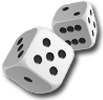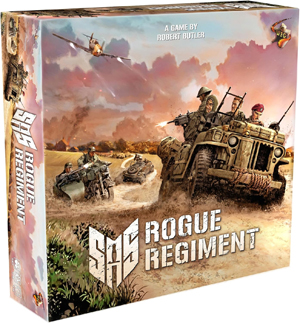



play board games
Board game reviews, strategy tips & session reports
SAS Rogue Regiment Board Game Review
 Stats:
Stats:
No. of players: 1-4
Amount of time to play: 30-180 min (depending on mission)
Age requirements: 14+
Set-up time: about 10 min
SAS Rogue Regiment is a cooperative, tactical, stealth board game set in the world of special forces operations. Players take on the roles of members of an elite SAS unit, completing high-stakes missions behind enemy lines.
SAS Rogue Regiment Rules Description:
In SAS Rogue Regiment you take on the role of Allied soldiers infiltrating Axis territory after D-Day. You and your friends control operators trying to meet each mission’s goals while avoiding detection and death. The Axis units are governed by set rules and automation. Your job is to outmaneuver (or quietly eliminate) them and complete the mission.
To begin, you look at the mission you want to play and set up the map and player board for your operator. The map setup will show you where to start the operators and enemy units. Missions will dictate the number of operators for the mission and sometimes which operators are involved in the mission.
Your Operators have equipment to help them on their mission and taking advantage of the terrain and buildings on the board is important too. There might be Axis vehicles to avoid (or attack) as well as fuel barrels to explode and units you can stealthfully eliminate. Making too much noise by firing guns can alert enemies to your presence. Those enemies can let others know your whereabouts and things can escalate fast.
Each turn is broken up into six phases: Operator Phase, Axis Advance Phase, Event Phase, Axis Patrol Phase, Axis Attack Phase, and the End Phase.
The Operator Phase is when players take their actions. Turns may be taken in any order, but must be completed before moving on to another player’s turn. Each turn you get four action points (AP) to spend on different actions. Most actions cost one or two AP and include moving, sprinting, aiming and attacking. You’ll want to take these actions without being seen or heard though.
There is a Stealth Meter that tracks just how secretive your team has been. If this tracker ever reaches zero, alarms sound and you have entered battle. Being in Stealth vs Battle mode changes some rules and how the Axis units move and play.
During the Axis Advance Phase (while still being in stealth mode) any Axis units that have been alerted to an Operator’s presence moves towards them. If you have already sounded the alarm all Axis units converge on your team.
To begin the Event Phase you draw an event card and follow the left side if your team is still in stealth mode or the right side if they are in battle mode. Stealth events can rotate Axis sentry or patrolling units, spawn new Axis units, advance the stealth meter towards zero or grant you a cigarette break token. This token can be used to avoid detection for one turn by using it on a n enemy unit. Battle events spawn units and let sentry units rotate until they have line of sight (LOS) on one of your team members.
In the Axis Patrol Phase any patrol units move four spaces (or until they spot a player) along their patrol route.
The Axis Attack Phase is exactly what it sounds like. Any Axis units with LOS to your team attacks them. Different units need specific results on a d6 to hit and there are modifiers for range and cover. Each hit removes one health from the Operator.
During the End phase there are checks that might move the Stealth Meter and cleanup of bodies and other things that happen on the board.
If you meet the mission’s objective, you win. If all the Operators have been killed or captured, you lose.
Quick Review of SAS Rogue Regiment:
SAS stands for Stealth and Sabotage and you’ll be doing both those things in this cooperative board game. You can sneak up on enemies and take them out silently, but be sure to hide the body.
The components for this game are good. The cardboard tokens are thick and durable, the art looks nice, and the cards are well-designed and of good quality. The rulebook is well-written with lots of examples. My biggest complaint about the components is that the artwork on the different tokens is too similar. It is not easy to differentiate which unis are which.
Each turn you’ll be figuring out where patrolling enemies will move or how to hide from a nearby sentry unit. You have some information, and deciding the best course of action based on what you know is a fun puzzle.
The missions feel like an action movie scene. There are rescue missions, raid missions, even assassination missions. There is a lot of action as you go about your mission and you need to be quiet about it. Make too much noise and the enemy is alerted which makes things much tougher. It feels tense and gets you invested.
I do like a lot about SAS Rogue Regiment, but there are a couple things to know before purchasing. First is the learning curve. It’s not that the game is hard to play, it is the number of little rules you need to remember. It will take a few games to absorb and remember these and you’ll need to look some things up a few times. Thankfully there is a pretty decent index on the back of the rule book.
Another thing to know is the player count is not consistent. Some missions require less than four operators. This is not a big deal. But if you expected to play all nine missions with three of your friends you can’t. Some of the intro missions act as tutorials and ramp things up to help you learn the game. They have fewer operators but so do a couple later ones.
This game will appeal to people that enjoy the Commandos PC game or other stealth action games. It is a puzzle that has pieces that might change shape instantly and you’ll need to refigure things out. Or you might just be exposed and battling for your life. If that tension appeals to you, pick it up. If that sounds frustrating, then you might want to try this SAS Rogue Regiment first.
Score and synopsis: (Click here for an explanation of these review categories.)
Strategy 4 out of 6
Luck 5 out of 6
Player Interaction 4 of 6
Replay Value 4 out of 6
Complexity 4 out of 6
Fun 4 out of 6
Overall 4 out of 6

Leave a Reply